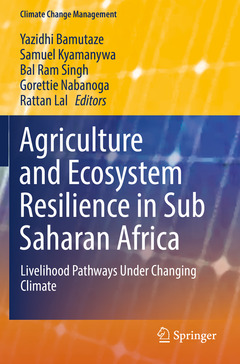Description
Agriculture and Ecosystem Resilience in Sub Saharan Africa, 1st ed. 2019
Livelihood Pathways Under Changing Climate
Climate Change Management Series
Coordinators: Bamutaze Yazidhi, Kyamanywa Samuel, Singh Bal Ram, Nabanoga Gorettie, Lal Rattan
Language: English
Subjects for Agriculture and Ecosystem Resilience in Sub Saharan Africa:
Keywords
Climate risk management; Tropical Africa; Agroecosystem resilience; Information and Communication Technology (ICT); Tranformative agriculture; Water-Ecosystem-Agriculture Nexus; Wetland dynamics; Agronomic management strategies; Ecological sustainability; Crop biotechnology; Agricultural development landscape; Livestock production; Landscape processes; Gender dynamics in agriculture; climate change; Climate change management
Publication date: 08-2020
763 p. · 15.5x23.5 cm · Paperback
Publication date: 06-2019
763 p. · 15.5x23.5 cm · Hardback
Description
/li>Contents
/li>Biography
/li>Comment
/li>
Bal Ram Singh, PhD is a professor emeritus at the Norwegian University of Life Sciences. He earned his Ph.D. degree from G.B. Pant University of Agriculture & Technology, India. His program focuses on bioavailability and mobility of heavy metals in the soil and plant system, fertility management and agricultural sustainability
Discusses emerging contexts of agricultural and ecosystem resilience in Sub Saharan Africa
Addresses the historical and contemporary aspects of agricultural productivity in Africa
Offers insight into agricultural technology adoption and utility for productivity and livelihoods




